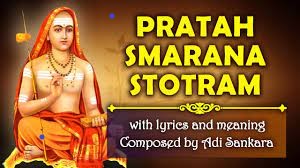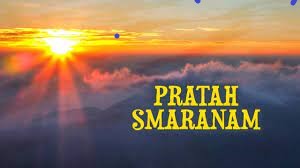PRATAH SMARANAM MANTRA, a Vedantic meditation (Nidhidhyasanam) composed by Sri Adi Shankaracharya consisting of three profound verses summarizes the essence of Advaita Vedanta. In this meditation verse, the meditator, the Vedantic student, invokes his or her essential higher nature and contemplates on the self, holds up to that blessings, and starts a day with a relatively peaceful mind with self-confidence and be better prepared to face any day-to-day challenges.
Pratah Smaranam Mantra consists of three verses where the first verse does jeevatma Paramatma aikyam, the second verse deals with the knowledge of Advaita, and the third verse negates anatma (body, mind, world). Therefore, with the knowledge of the second verse, joining the first verse and third verse we get Aham Brahma Asmi siddhi, I AM BRAHMAN knowledge.
Chanting Pratah Smaranam Mantra at the dawn by contemplating its meaning is deeply significant. When the first thoughts, words, and actions of the day are divinized and consecrated they will have a greater influence on the individual’s life and will pay the way for Spiritual progress.
PRATAH SMARANAM MANTRA LYRICS WITH MEANINGS
Often there are two important principles used in Vedantic scriptures to recognize the Atma. Sri Shankaracharya uses this principle in this Pratah Smaranam mantra.
1) I am different from whatever I experience – whatever I experience is an object and I am the subject which is different from the object.
2) Every experienced attribute belongs to the experienced object and not to the experiencer, the subject.
Keep these principles in mind to better understand the mantra meanings below.

PRATAH SMARAN – Verse 1
prātaḥ smarāmi hṛdi saṃsphuradātmatattvaṃ
sachchitsukhaṃ paramahaṃsagatiṃ turīyam ।
yatsvapnajāgarasuṣuptamavaiti nityaṃ
tadbrahma niṣkalamahaṃ na cha bhūtasaṅghaḥ ॥ 1 ॥
At dawn I remember my true nature, shining brilliantly in the heart, which is the very existence, consciousness, and happiness called Turiyaam, the fourth state which witnesses the other three states of dream, waking, and deep sleep. I am that Brahman who is limitless and divisionless and not a cluster of elements.
Here the nature of Atma is revealed as per the Upanishad scriptures. In this Pratah Smaranam mantra, Atma is explained as the witness consciousness which is always available in the mind as the experiencer of the three states (waker, dream, deep sleep) called avasthaathraya sakshi. From its own standpoint, Atma is called Tureeyam, which is limitless, division-less (Niskalam Brahman) Consciousness.
Prātaḥ smarāmi hṛdi saṃsphuradātmatattvaṃ – In the Morning, I meditate on myself, the pure Atma, which shines in my mind.
Sachchitsukhaṃ paramahaṃsagatiṃ turīyam – This Atma, which is I myself is of the nature of Consciousness, the very Existence and Happiness, and which is beyond time and space is called ‘Tureeyam’, the fourth state. Knowing this ‘Turieeyaam’ Atma happens to be a goal of all Paramahamsa sanyasis.
‘Yatsvapnajāgarasuṣuptim avaiti nityaṁ –I am the consciousness principle different from body and mind and which is always witnessing the three states of experiences, Jagrat, Swapna and the deep sleep states regularly.
Tatbrahma niṣkalamahaṁ na tu bhūtasaṁgha: I am not the body-mind made of the 5 elements; I am not this bhouthica prapanja which is an object of my experience. I am that Brahman, the infinite, and nishkalam, the division-less one.
So, to consolidate, I am the atma-thatwam, which is ever-experienced, division-less, and infinite. Which is different from body, and mind, and is the witness of all the avasthaas, and is satchitanantha ananda, which is called the Turiyaam, the fourth. This atma, is my higher nature. I meditate on this Atma as myself in the morning.
PRATAH SMARAN – Verse 2
pratarbhajami manasaṃ vachasamagamyaṃ
vacho vibhanti nikhila yadanugraheṇa ।
yannetineti vachanairnigama avochuḥ
taṃ devadevamajamachyutamehuragryam ॥ 2 ॥
At dawn, I sing and praise my consciousness, which cannot be accessed by mind and speech, but by the grace of which all thoughts and words shine. By negating the attributes that do not belong to me through the words `not this’, `not this, I get myself revealed as the subject I, the Consciousness. This Consciousness who is God of gods is unborn, unchanging, and is the cause of everything.
Pratarbhajami manasaṃ vachasamagamyaṃ – In the Morning, I sing and praise the Atma, myself which is not an object of knowledge. Then how do we realize or recognize this atma? Shankaracharya says manasaṃ vachasamagamyaṃ – Manas stands for mind and sense organs and vachas stands for written and spoken words. Atma is agamyam, meaning inaccessible. Atma is unobjectifiable, unreachable for Manas and Vachas, Atma is never an object of knowledge and is not experienceable as an object through a specific experience, but it is ever experienced as the subject, in and through all the specific experiences.
Vacho vibhanti nikhila yadanugraheṇa – All the words, thoughts, and objects are experienced because of what yadh anugrahenna– the ever-experienced subject alone.
Yam nethi nethi vachanair nigamaah avochuḥ – nigamaah means Veda. Nethi Nethi vachanair means do you know. As per Veda, we talk about any attribute because we know, as it is known, it belongs to a known object. Therefore, it does not belong to Me the Consciousness. If it is a known attribute, it belongs to the known mind. I, the knower, Atma am ever free from sorrow, emotion, and depression. I am ever free Brahman, free from all limitations.
That means the attributes of the object have been thrown on I-the-subject. Vedanta is only asking us to remove the attributes from the subject, I. Vedanta doesn’t reveal the I. Vedanta asks us only to negate the attributes as they all do not belong to the subject, I.
And taṃ devadevamajamachyutamehuragryam – that atma is talked about in the Vedas through various words. Deva devam. Deva devam means the light of all lights. Light makes other things known by illumining. Atma makes light itself known. As it makes the light known, consciousness becomes the light of lights called jyothishaam jyothi.
Ajam achutham. Ajam means janma rahitham, Achutham – maranna rahitham. Mortal is an adjective I use for myself. So, Mortality is it a known attribute or an unknown attribute? It must be a known attribute because you are talking about that. If it is a known attribute, it belongs to the known physical body, it can never belong to the knower I. Therefore I am mortal or immortal. I am immortal. And agriyam – agriyam means kaaranam. Which is the cause of all. Kaaranam means adhishtaanam, sarva kaaranam. To that Atma, I praise and sing, Bhajaami.
PRATAH SMARAN – Verse 3
pratarnamami tamasaḥ paramarkavarṇaṃ
purṇaṃ sanatanapadaṃ puruṣottamakhyam ।
yasminnidaṃ jagadasesamasesamurtau
rajjvaṃ bhujangama iva pratibhasitaṃ vai ॥ 3 ॥
At dawn, I bow to that eternal supreme being known as Purusha, the Highest Self who is beyond the darkness of ignorance and self-effulgent like the Sun. Who is the essence of everything and on whom the entire universe appears, just like the Mitya snake appearing on the Satyam rope.
Pratarnamami tamasaḥ paramarkavarṇaṃ – atma the consciousness is beyond ignorance, it is untouched, unaffected, and not covered by ignorance. It illumines the very ignorance and proves the ignorance hence called ‘tamasah param’. Arkka varnam – This Atam is self-effulgent, self-evident, and self-proven, like the SUN.
Purṇaṃ sanatanapadaṃ puruṣottamakhyam – Atam the consciousness is ever full and complete, and it is sanaathana padam – the one eternal goal of all human beings. puruṣottamakhyam, this non-material consciousness principle, the nirguna Chaitanyam is known as Supreme Purusha, Purusottama.
Yasminnidaṃ jagadasesamasesamurtau– the whole universe in non-substantial name and form appears upon the Atma as an object. Then what are the subject and substance? I the observer alone am the only substance in the creation and the world is dependent on me, the subject. Hence the atma is called ashesha moorthy, sarva adhishtaanam.
Rajjvaṃ bhujangama iva pratibhasitaṃ vai – The whole Mitya universe appears on the Atma, just like the frightening mitya snake which does not have independence existence appears upon the sathyam rope.
Conclusion
ślōkatrayamidaṁ puṇyaṁ lōkatrayavibhūṣaṇaṁ
prāta:kālē paṭhēnnityaṁ sa gacchētparamaṁ padam ||
prāta:kālē paṭhēnnityaṁ sa gacchētparamaṁ padam ||The above three verses of pratah smaranam mantra deals with atma vidya that are very sacred like the greatest ornament in all the three worlds as it is from the sacred Vedas dealing with the sacred atma.
Suppose a person reads these three verses in the morning, his day-to-day problems that appear big will become insignificant. And such a person will attain the highest goal of Moksha, Parama Purushartha.
- The Namagiri Thayar Mantra – For Wisdom, Creativity & Prosperity - April 29, 2024
- Krishnashtakam – “Krishnam Vande Jagadgurum” – Lyrics & Meaning - April 4, 2024
- Karadarshanam – “Karagre Vasate Lakshmi” – Meaning & Benefits - March 26, 2024


0 Comments